Related Research Articles
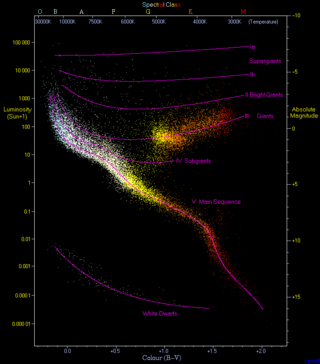
In astronomy, the main sequence is a classification of stars which appear on plots of stellar color versus brightness as a continuous and distinctive band. Stars on this band are known as main-sequence stars or dwarf stars, and positions of stars on and off the band are believed to indicate their physical properties, as well as their progress through several types of star life-cycles. These are the most numerous true stars in the universe and include the Sun. Color-magnitude plots are known as Hertzsprung–Russell diagrams after Ejnar Hertzsprung and Henry Norris Russell.
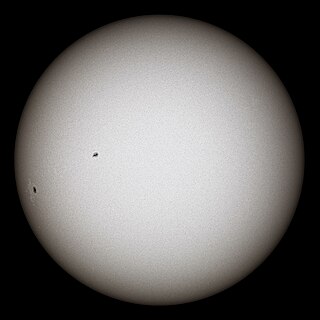
A star is a luminous spheroid of plasma held together by self-gravity. The nearest star to Earth is the Sun. Many other stars are visible to the naked eye at night; their immense distances from Earth make them appear as fixed points of light. The most prominent stars have been categorised into constellations and asterisms, and many of the brightest stars have proper names. Astronomers have assembled star catalogues that identify the known stars and provide standardized stellar designations. The observable universe contains an estimated 1022 to 1024 stars. Only about 4,000 of these stars are visible to the naked eye—all within the Milky Way galaxy.

Stellar evolution is the process by which a star changes over the course of its lifetime and how it can lead to the creation of a new star. Depending on the mass of the star, its lifetime can range from a few million years for the most massive to trillions of years for the least massive, which is considerably longer than the current age of the universe. The table shows the lifetimes of stars as a function of their masses. All stars are formed from collapsing clouds of gas and dust, often called nebulae or molecular clouds. Over the course of millions of years, these protostars settle down into a state of equilibrium, becoming what is known as a main-sequence star.

X-ray astronomy is an observational branch of astronomy which deals with the study of X-ray observation and detection from astronomical objects. X-radiation is absorbed by the Earth's atmosphere, so instruments to detect X-rays must be taken to high altitude by balloons, sounding rockets, and satellites. X-ray astronomy uses a type of space telescope that can see x-ray radiation which standard optical telescopes, such as the Mauna Kea Observatories, cannot.
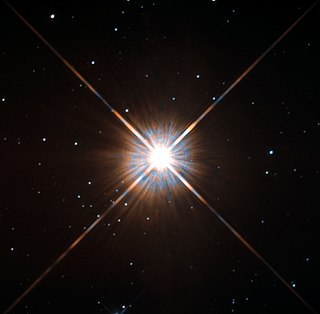
A red dwarf is the smallest kind of star on the main sequence. Red dwarfs are by far the most common type of fusing star in the Milky Way, at least in the neighborhood of the Sun. However, due to their low luminosity, individual red dwarfs cannot be easily observed. From Earth, not one star that fits the stricter definitions of a red dwarf is visible to the naked eye. Proxima Centauri, the star nearest to the Sun, is a red dwarf, as are fifty of the sixty nearest stars. According to some estimates, red dwarfs make up three-quarters of the fusing stars in the Milky Way.
Starspots are stellar phenomena, so-named by analogy with sunspots. Spots as small as sunspots have not been detected on other stars, as they would cause undetectably small fluctuations in brightness. The commonly observed starspots are in general much larger than those on the Sun: up to about 30% of the stellar surface may be covered, corresponding to starspots 100 times larger than those on the Sun.
Differential rotation is seen when different parts of a rotating object move with different angular velocities at different latitudes and/or depths of the body and/or in time. This indicates that the object is not rigid. In fluid objects, such as accretion disks, this leads to shearing. Galaxies and protostars usually show differential rotation; examples in the Solar System include the Sun, Jupiter and Saturn.

Red supergiants (RSGs) are stars with a supergiant luminosity class and a stellar classification K or M. They are the largest stars in the universe in terms of volume, although they are not the most massive or luminous. Betelgeuse and Antares A are the brightest and best known red supergiants (RSGs), indeed the only first magnitude red supergiant stars.

Asteroseismology is the study of oscillations in stars. Stars have many resonant modes and frequencies, and the path of sound waves passing through a star depends on the local speed of sound, which in turn depends on local temperature and chemical composition. Because the resulting oscillation modes are sensitive to different parts of the star, they inform astronomers about the internal structure of the star, which is otherwise not directly possible from overall properties like brightness and surface temperature.

The asymptotic giant branch (AGB) is a region of the Hertzsprung–Russell diagram populated by evolved cool luminous stars. This is a period of stellar evolution undertaken by all low- to intermediate-mass stars (about 0.5 to 8 solar masses) late in their lives.

An A-type main-sequence star or A dwarf star is a main-sequence star of spectral type A and luminosity class V (five). These stars have spectra defined by strong hydrogen Balmer absorption lines. They measure between 1.4 and 2.1 solar masses (M☉), have surface temperatures between 7,600 and 10,000 K, and live for about a quarter of the lifetime of our Sun. Bright and nearby examples are Altair (A7), Sirius A (A1), and Vega (A0). A-type stars do not have convective zones and thus are not expected to harbor magnetic dynamos. As a consequence, because they do not have strong stellar winds, they lack a means to generate X-ray emissions.
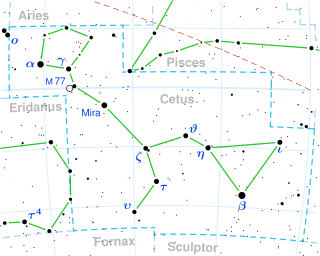
Kappa1 Ceti, Latinized from κ1 Ceti, is a variable yellow dwarf star approximately 30 light-years away in the equatorial constellation of Cetus.
In astrophysics, the von Zeipel theorem states that the radiative flux in a uniformly rotating star is proportional to the local effective gravity . The theorem is named after Swedish astronomer Edvard Hugo von Zeipel.
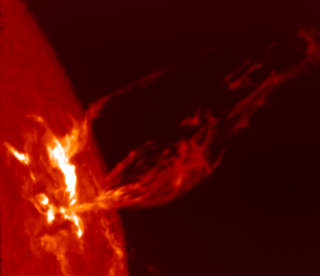
A stellar magnetic field is a magnetic field generated by the motion of conductive plasma inside a star. This motion is created through convection, which is a form of energy transport involving the physical movement of material. A localized magnetic field exerts a force on the plasma, effectively increasing the pressure without a comparable gain in density. As a result, the magnetized region rises relative to the remainder of the plasma, until it reaches the star's photosphere. This creates starspots on the surface, and the related phenomenon of coronal loops.

Stellar rotation is the angular motion of a star about its axis. The rate of rotation can be measured from the spectrum of the star, or by timing the movements of active features on the surface.
Gyrochronology is a method for estimating the age of a low-mass (cool) main sequence star from its rotation period. The term is derived from the Greek words gyros, chronos and logos, roughly translated as rotation, age, and study respectively. It was coined in 2003 by Sydney Barnes to describe the associated procedure for deriving stellar ages, and developed extensively in empirical form in 2007.

HD 269810 is a blue giant star in the Large Magellanic Cloud. It is one of the most massive and most luminous stars known, and one of only a handful of stars with the spectral type O2.

R136a1 is one of the most massive and luminous stars known, at nearly 200 M☉ and nearly 4.7 million L☉, and is also one of the hottest, at around 46,000 K. It is a Wolf–Rayet star at the center of R136, the central concentration of stars of the large NGC 2070 open cluster in the Tarantula Nebula in the Large Magellanic Cloud. The cluster can be seen in the far southern celestial hemisphere with binoculars or a small telescope, at magnitude 7.25. R136a1 itself is 100 times fainter than the cluster and can only be resolved using speckle interferometry.
14 Ceti is a single star in the equatorial constellation of Cetus. It is faintly visible to the naked eye under good viewing conditions, having an apparent visual magnitude of 5.84. The distance to 14 Ceti can be estimated from its annual parallax shift of 17.4″, which puts it 187 light years away. It is moving further from the Earth with a heliocentric radial velocity of +11 km/s, having recently come no closer than 178 ly.

EK Eridani is a single variable star in the equatorial constellation of Eridanus. It has the designation HR 1362 from the Bright Star Catalogue; EK Eridani is the variable star designation, abbreviated EK Eri. This star is dimly visible to the naked eye with a brightness that fluctuates around 6.15. Based on parallax measurements, it is located at a distance of 209 light years from the Sun. The star is drifting further away with a heliocentric radial velocity of 6.9 km/s.
References
- ↑ Beyer, Alexa C.; White, Russel J. (2024). "The Kraft Break Sharply Divides Low-mass and Intermediate-mass Stars". The Astrophysical Journal. 973: 28. doi: 10.3847/1538-4357/ad6b0d .
- ↑ Kraft, R. P. (1967), "Studies of Stellar Rotation. V. The Dependence of Rotation on Age among Solar-Type Stars", Astrophysical Journal, 150: 551, Bibcode:1967ApJ...150..551K, doi: 10.1086/149359
- ↑ Schatzman, E. (1962), "A theory of the role of magnetic activity during star formation", Annales d'Astrophysique, 25: 18, Bibcode:1962AnAp...25...18S
- ↑ Maeder, A. (2009), Physics, Formation and Evolution of Rotating Stars (PDF), Astronomy and Astrophysics Library, Bibcode:2009pfer.book.....M, doi:10.1007/978-3-540-76949-1, ISBN 978-3-540-76948-4